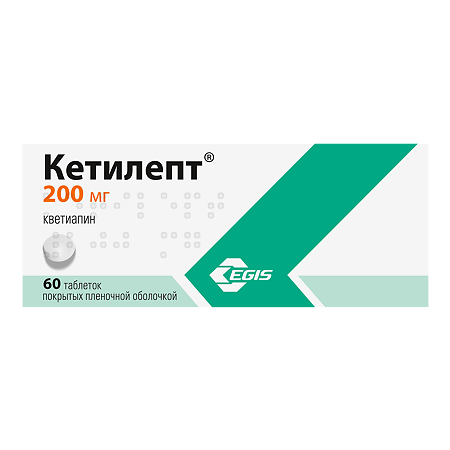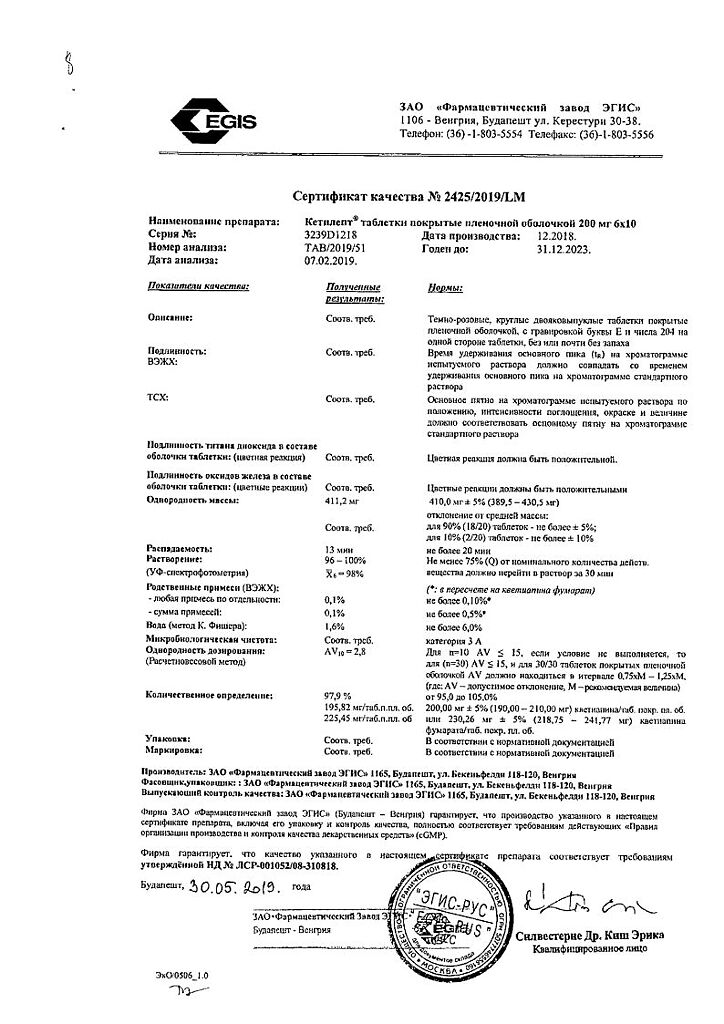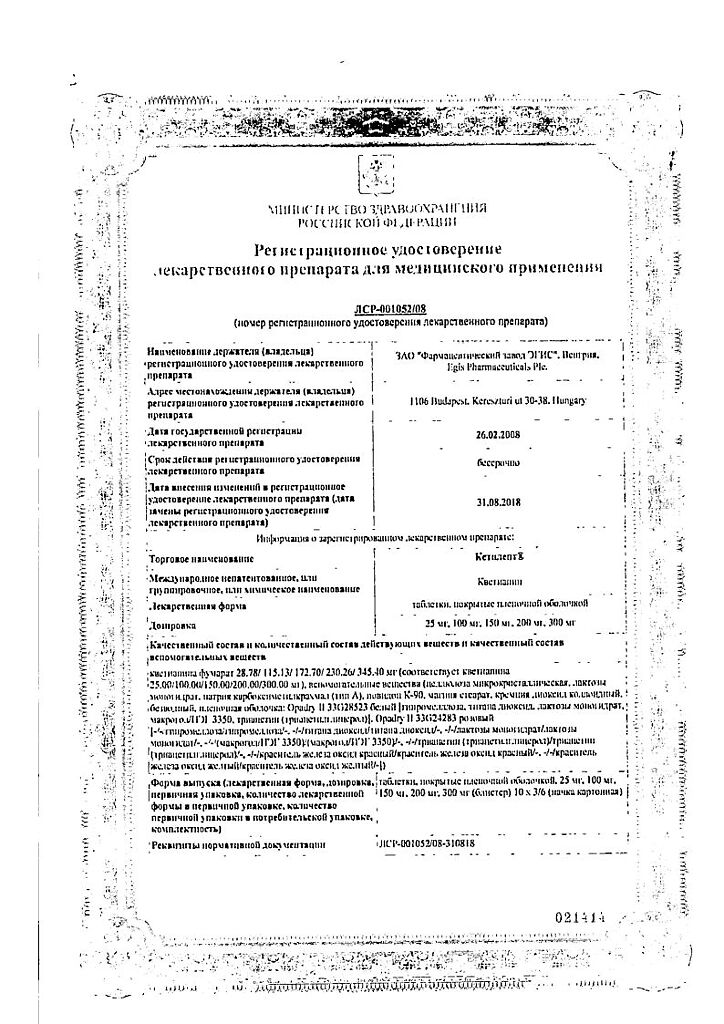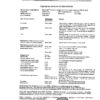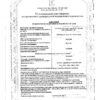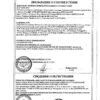No products in the cart.
Quetilept, 200 mg 60 pcs.
€57.66 €48.05
Out of stock
(E-mail when Stock is available)
Description
Cetilept has antipsychotic effects.
Pharmacodynamics
The mechanism of action. Quetiapine is an atypical antipsychotic drug that exhibits a higher affinity for serotonin receptors (5NT2) than for brain dopamine receptors D1 and D2. Quetiapine also has a higher affinity for histamine and α1 adrenoreceptors and a lower affinity for α2 adrenoreceptors. No appreciable affinity of quetiapine for cholinergic muscarinic and benzodiazepine receptors was found. In standard tests, quetiapine shows antipsychotic activity.
Pharmacodynamic effects
Results from a study of extrapyramidal symptoms (EPS) in animals revealed that quetiapine causes mild catalepsy at a dose that effectively blocks dopamine D2 receptors. Quetiapine causes a selective decrease in the activity of mesolimbic A10 dopaminergic neurons compared to A9 nigrostriatal neurons involved in motor function.
The clinical studies showed no differences between the use of quetiapine (at doses of 75-750 mg/day) and placebo in the incidence of extrapyramidal symptoms and the concomitant use of anticholinergic drugs. Quetiapine does not cause prolonged increases in plasma prolactin concentrations. Multiple fixed-dose studies have found no difference in prolactin levels when using quetiapine or placebo.
Quetiapine has been shown to be effective in treating both positive and negative symptoms of schizophrenia in clinical trials.
The effects of quetiapine on the 5NT2 and D2 receptors last up to 12 h after taking the drug.
Pharmacokinetics
On oral administration, quetiapine is well absorbed from the GI tract and is actively metabolized in the liver. The major plasma metabolites have no marked pharmacological activity.
Eating does not significantly affect the bioavailability of quetiapine. T1/2 is about 7 h. Approximately 83% of quetiapine is bound to plasma proteins. The pharmacokinetics of vetiapine are linear; there are no differences in pharmacokinetics between men and women.
The average clearance of quetiapine in elderly patients is 30-50% less than in patients aged 18 to 65 years.
The mean plasma clearance of quetiapine is approximately 25% lower in patients with severe renal impairment (creatinine2 Cl) and in patients with liver damage (stabilized alcoholic cirrhosis), but individual clearance rates are within limits consistent with those of healthy individuals.
Approximately 73% of quetiapine is excreted in the urine and 21% in the feces. Less than 5% of quetiapine is not metabolized and is excreted unchanged by the kidneys or in the feces. It has been established that CYP3A4 is the key enzyme of cytochrome P450-mediated metabolism of quetiapine.
In a study of the pharmacokinetics of quetiapine in different dosages, it has been shown that when quetiapine is administered before ketoconazole or simultaneously with ketoconazole, there is an average increase in Cmax and AUC of quetiapine of 235 and 522% respectively, and a decrease in quetiapine clearance of 84% on average. The T1/2 of quetiapine increased, but the mean Tmax did not change.
Quetiapine and some of its metabolites have weak inhibitory activity against cytochrome P450 enzymes 1A2, 2C9, 2C19, 2D6 and 3A4, but only at concentrations 10-50 times higher than those observed at the commonly used effective dose of 300-450 mg/day.
Based on in vitro results, concomitant administration of quetiapine with other drugs should not be expected to result in clinically significant inhibition of cytochrome P450-mediated metabolism of other drugs.
Indications
Indications
Acute and chronic psychoses, including schizophrenia;
treatment of manic episodes in the structure of bipolar disorder;
treatment of depressive episodes of moderate to severe severity in the structure of bipolar disorder.
Pharmacological effect
Pharmacological effect
Ketilept has an antipsychotic effect.
Pharmacodynamics
Mechanism of action. Quetiapine is an atypical antipsychotic drug that exhibits higher affinity for serotonin receptors (5HT2) than for dopamine D1 and D2 receptors in the brain. Quetiapine also has a higher affinity for histamine and α1-adrenergic receptors and a lower affinity for α2-adrenergic receptors. No significant affinity of quetiapine for cholinergic muscarinic and benzodiazepine receptors was found. In standard tests, quetiapine exhibits antipsychotic activity.
Pharmacodynamic effects
Results from studies of extrapyramidal symptoms (EPS) in animals revealed that quetiapine causes mild catalepsy at a dose that effectively blocks dopamine D2 receptors. Quetiapine causes a selective decrease in the activity of mesolimbic A10 dopaminergic neurons compared to A9 nigrostriatal neurons involved in motor function.
Clinical studies showed no differences between the use of quetiapine (at a dose of 75–750 mg/day) and placebo in the incidence of extrapyramidal symptoms and in the concomitant use of anticholinergic drugs. Quetiapine does not cause a prolonged increase in plasma prolactin concentrations. Multiple fixed-dose studies have shown no difference in prolactin levels between quetiapine and placebo.
In clinical studies, quetiapine has been shown to be effective in treating both positive and negative symptoms of schizophrenia.
The effect of quetiapine on 5HT2 and D2 receptors lasts up to 12 hours after taking the drug.
Pharmacokinetics
When administered orally, quetiapine is well absorbed from the gastrointestinal tract and is actively metabolized in the liver. The main metabolites found in plasma do not have pronounced pharmacological activity.
Food intake does not significantly affect the bioavailability of quetiapine. T1/2 is about 7 hours. Approximately 83% of quetiapine is bound to plasma proteins. The pharmacokinetics of quetiapine is linear; there are no differences in pharmacokinetic parameters between men and women.
The average clearance of quetiapine in elderly patients is 30–50% less than in patients aged 18 to 65 years.
The average plasma clearance of quetiapine is approximately 25% less in patients with severe renal impairment (Cl creatinine2) and in patients with liver damage (stable alcoholic cirrhosis), but individual clearance rates are within the range of those in healthy individuals.
Approximately 73% of quetiapine is excreted in urine and 21% in feces. Less than 5% of quetiapine is not metabolized and is excreted unchanged by the kidneys or in feces. It has been established that CYP3A4 is a key enzyme in the metabolism of quetiapine, mediated by cytochrome P450.
A study of the pharmacokinetics of quetiapine at various dosages showed that when quetiapine was prescribed before taking ketoconazole or simultaneously with ketoconazole, the Cmax and AUC of quetiapine increased by an average of 235 and 522%, respectively, and the clearance of quetiapine decreased by an average of 84%. T1/2 of quetiapine increased, but the average Tmax did not change.
Quetiapine and some of its metabolites have weak inhibitory activity against cytochrome P450 enzymes 1A2, 2C9, 2C19, 2D6 and 3A4, but only at concentrations 10–50 times higher than those observed at the commonly used effective dosage of 300–450 mg/day.
Based on in vitro results, it should not be expected that the simultaneous administration of quetiapine with other drugs will lead to clinically significant inhibition of cytochrome P450-mediated metabolism of other drugs.
Special instructions
Special instructions
Ketilept should be used with caution in patients with known cardiovascular disease, cerebrovascular disease, or other conditions predisposing to hypotension.
Ketilept may cause orthostatic hypotension, especially during the initial period of dose adjustment; it occurs more often in older than younger patients. There was no relationship between quetiapine and an increase in the QTc interval. However, when prescribing quetiapine simultaneously with drugs that prolong the QTc interval, caution must be exercised, especially in the elderly.
There were no differences in the incidence of seizures in patients taking Ketilept or placebo. However, as with other antipsychotic drugs, caution is recommended when treating patients with a history of seizures.
Ketilept, like other antipsychotics, can cause tardive dyskinesia with long-term use. If signs and symptoms of tardive dyskinesia occur, dose reduction or discontinuation of the drug should be considered.
Neuroleptic malignant syndrome may be associated with antipsychotic treatment. Clinical manifestations of the syndrome include hyperthermia, altered mental status, muscle rigidity, instability of the autonomic nervous system, and increased CPK levels. In such cases, Ketilept should be discontinued and appropriate treatment administered.
Acute withdrawal reactions: Acute withdrawal symptoms (including nausea, vomiting, insomnia) have been described in very rare cases after abrupt cessation of high-dose antipsychotic medications. Relapses of symptoms of psychosis and the appearance of disorders associated with involuntary movements (akathisia, dystonia, dyskinesia) are possible. Therefore, if it is necessary to stop taking the drug, a gradual dose reduction is recommended.
When preparing a diet for patients with lactose intolerance, it should be taken into account that film-coated tablets 25 mg, 100 mg, 150 mg, 200 mg and 300 mg contain lactose, respectively, 4.42 mg, 17.05 mg, 25.47 mg, 34.1 mg and 50.94 mg. This drug should not be used in patients with rare hereditary disorders of galactose intolerance, hereditary Sami lactose deficiency or glucose-galactose malabsorption syndrome.
Taking into account that quetiapine primarily affects the central nervous system, the drug should be used with caution in combination with other drugs that have a depressant effect on the central nervous system or alcohol. In controlled clinical studies of quetiapine, there were no cases of sustained severe neutropenia or agranulocytosis. During the observation period after registration of the drug, leukopenia and/or neutropenia resolved after discontinuation of quetiapine administration. Possible risk factors for leukopenia and/or neutropenia include a pre-existing low white blood cell count and a history of drug-induced leukopenia and/or neutropenia.
Like other antipsychotics with alpha1-blocking activity, Ketilept may cause orthostatic hypotension with dizziness, tachycardia and (in some patients) syncope, especially during the initial dose titration period. In very rare cases, hyperglycemia and worsening of pre-existing diabetes have been observed while taking quetiapine. A connection has been established between quetiamine intake and a low-dose induced decrease in thyroid hormone levels (T4 and free T4).
The maximum reduction occurred during the first two to four weeks of taking quetiapine, but no further reduction occurred with a long course of treatment. Less significant reductions in T3 and reverse T3 were observed only at higher doses of quetiapine. Levels of TSH and TSH (thyroxine-binding globulin) remained unchanged. In almost all cases, discontinuation of quetiapine resulted in restoration of T4 and free T4 levels, regardless of the duration of treatment. No clinically significant hypothyroidism was detected.
The effectiveness and safety of quetiapine in children and adolescents has not been established.
Due to its effect on the central nervous system, Ketilept may cause drowsiness. Therefore, in the first stages of treatment, for an individually determined period of time, the patient should be prohibited from driving motor vehicles or dangerous machinery. In the future, the degree of restrictions is set individually.
Active ingredient
Active ingredient
Quetiapine
Composition
Composition
1 tablet contains:
active substance:
quetiapine 200 mg (as quetiapine fumarate);
excipients:
microcrystalline cellulose,
lactose monohydrate,
sodium carboxymethyl starch,
povidone,
magnesium stearate,
silicon dioxide,
triacetin,
macrogol,
lactose monohydrate,
titanium dioxide,
hypromellose.
Pregnancy
Pregnancy
Category C. The safety and effectiveness of quetiapine during pregnancy has not been established.
The use of Ketilpet during pregnancy is possible only if the expected benefit to the mother outweighs the potential risk to the fetus.
It is unknown whether quetiapine is excreted in breast milk. If it is necessary to use Ketilpet during lactation (breastfeeding), the issue of stopping breastfeeding should be decided.
Contraindications
Contraindications
Hypersensitivity to any of the components of Ketilept;
children’s age (efficacy and safety have not been studied).
With caution: in patients with cardiovascular and cerebrovascular diseases or other conditions predisposing to arterial hypotension, advanced age, liver failure, a history of seizures.
Side Effects
Side Effects
palpitations, dizziness when getting up;
drowsiness, dizziness;
dry mouth, diarrhea, or constipation;
rash, dry skin.
Interaction
Interaction
Particular caution is required when prescribing Ketilept in combination with other drugs that act on the central nervous system.
The results of an in vitro study showed that quetiapine and 9 of its metabolites in vivo are weak inhibitors of metabolic processes mediated by isoenzymes of the cytochrome P450 system (1A2, 2C9, 2C19, 2D6 and 3A4). CYP3A4 is the main enzyme responsible for P450-mediated metabolism of quetiapine.
The effect of other drugs on Ketilept:
The simultaneous use of Ketilept with phenytoin leads to an increase in plasma clearance of quetiapine, because Phenytoin induces cytochrome P450 isoenzyme 3A4. The combination of quetiapine (250 mg 3 times/day) and phenytoin (100 mg 2 times/day) increased the average clearance of quetiapine after oral administration by 5 times. To correct symptoms of schizophrenia in patients receiving concurrent quetiapine and phenytoin, increased doses of Ketilept or other liver enzyme inducers (including carbamazepine, barbiturates, rifampicin, corticosteroids) may be required. In these cases, caution is required when discontinuing phenytoin and/or switching to valproate, which does not have enzyme-inducing properties.
The simultaneous use of Ketilept with carbamazepine significantly increases the clearance of quetiapine, which leads to a decrease in the systemic exposure of quetiapine. Due to this interaction, higher doses of Ketilept may be required.
The simultaneous use of Ketilept with ketoconazole (200 mg/day for 4 days), a strong inhibitor of the CYP3A isoenzyme, reduces the clearance of quetiapine after oral administration by 84%, resulting in an increase in the concentration of quetiapine in the blood plasma by an average of 235%. Caution is required when combining Ketilept with ketoconazole and other inhibitors of cytochrome P450 isoenzymes, azole antifungals and macrolide antibiotics (including itraconazole, fluconazole, erythromycin); the dose of quetiapine should be reduced accordingly.
Regular daily administration of cimetidine (400 mg 3 times/day for 4 days), which is a nonspecific enzyme inhibitor, resulted in a 20% decrease in the average clearance of quetiapine (150 mg 3 times/day) from plasma after oral administration. When using Ketilept with cimetidine simultaneously, there is no need to change the dose of the former.
Thioridazine (200 mg 2 times/day) increased the plasma clearance of quetiapine (300 mg 2 times/day) by 65% after oral administration.
Concomitant use of quetiapine (300 mg 2 times/day) with the antipsychotic drug haloperidol (7.5 mg 2 times/day) or risperidone (3 mg 2 times/day) did not change the equilibrium pharmacokinetics of quetiapine.
Concomitant use of quetiapine (300 mg 2 times/day) with the antidepressant and CYP3A4 and CYP2D6 inhibitor fluoxetine (60 mg 1 time/day) or the known CYP2D6 inhibitor imipramine (75 mg 2 times/day) did not change the equilibrium pharmacokinetics of quetiapine.
Effect of Ketilept on other drugs:
Repeated daily administration of quetiapine (up to 750 mg/day with 3 doses) did not cause clinically significant changes in the clearance of antipyrine or its metabolites. This indicates that quetiapine does not have a significant inhibitory effect on liver enzymes involved in cytochrome P450-mediated metabolism of antipyrine.
Concomitant use of quetiapine (250 mg 3 times/day) with lithium did not affect any pharmacokinetic parameters of lithium at steady state.
The average clearance of lorazepam after oral administration (single dose 2 mg) was reduced by 20% while taking quetiapine (250 mg 3 times a day).
Smoking did not affect the clearance of quetiapine from blood plasma.
Since clinical studies have shown that quetiapine potentiates the cognitive and motor effects of alcohol in patients with psychosis, alcohol should not be consumed during treatment with Quetiapine.
Overdose
Overdose
Data on overdose of quetiapine are limited.
Symptoms: drowsiness, excessive sedation, tachycardia, decreased blood pressure; cases of severe overdose of quetiapine leading to death or coma have been reported extremely rarely.
Treatment: There are no specific antidotes to quetiapine. Symptomatic therapy and measures aimed at maintaining respiratory function, the cardiovascular system, ensuring adequate oxygenation and ventilation are carried out.
Medical observation should be continued until the patient recovers completely.
Storage conditions
Storage conditions
At a temperature not exceeding 25 °C
Shelf life
Shelf life
5 years
Manufacturer
Manufacturer
EGIS, Hungary
Additional information
| Shelf life | 5 years |
|---|---|
| Conditions of storage | At a temperature not exceeding 25 °C |
| Manufacturer | EGIS, Hungary |
| Medication form | pills |
| Brand | EGIS |
Related products
Buy Quetilept, 200 mg 60 pcs. with delivery to USA, UK, Europe and over 120 other countries.

